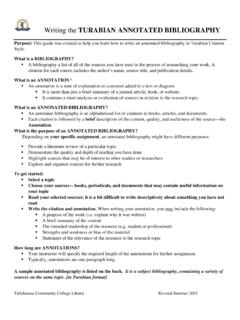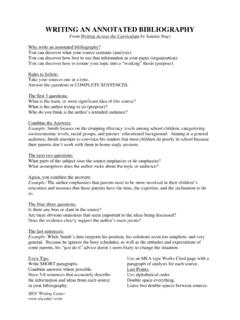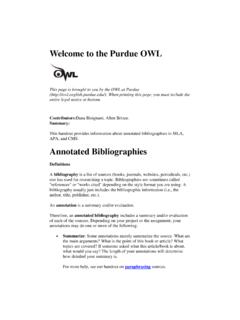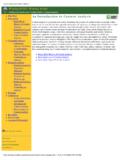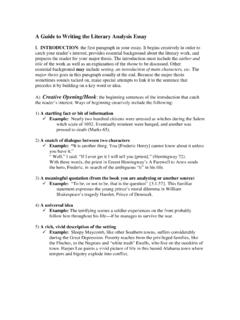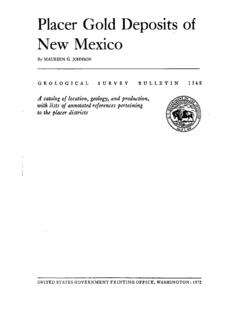Transcription of Guide to the Harvard Style of Referencing
1 Anglia Ruskin University 1 Guide to the Harvard Style of Referencing Fifth Edition January 2015 Anglia Ruskin University 2 1. GENERAL INTRODUCTION .. 5 What is Referencing .. 5 The Harvard System .. 6 Reference list or bibliography .. 7 Word Counts .. 7 2. CITING REFERENCES IN-TEXT .. 8 Author s name cited in the text .. 8 Author s name not cited directly in the text .. 8 More than one author cited in the text .. 8 Two or three authors for a work .. 9 Four or more authors for a 9 More than one author not cited directly in the text .. 10 Several works by one author in different years .. 10 Several works by one author in the same year .. 10 Chapter authors in edited works.
2 11 Corporate authors .. 11 No author .. 12 No date .. 12 Page numbers .. 12 Quoting portions of published text .. 13 Secondary sources (second-hand references) .. 14 Tables and diagrams .. 14 Websites .. 16 3. COMPILING THE REFERENCE LIST .. 17 General guidelines, layout and punctuation .. 17 4 USING BOOKS, JOURNALS AND NEWSPAPERS .. 18 Books .. 18 Books with one author .. 18 Books with multiple authors .. 19 Books which are edited .. 19 Chapters of edited books .. 20 Multiple works by the same 20 Books translations/imprints/reprints .. 21 E-books and pdfs .. 22 Pdf documents .. 23 Journal articles and newspapers .. 24 Print journal articles .. 24 Journal articles available through the University Library website/or database.
3 24 Magazine or journal articles available on the internet .. 26 Journal abstract from a database .. 26 Newspaper articles .. 26 Online newspaper articles .. 27 5. USING OTHER SOURCE TYPES .. 28 Anglia Ruskin University 3 Acts of Parliament .. 28 Secondary Legislation .. 28 Official publications such as Command Papers .. 29 Law reports .. 30 Annual reports .. 30 Archive material .. 31 British Standards and International Standards .. 31 Patents .. 31 Conference report and papers .. 32 Reports by organisations .. 33 Dissertations and Theses .. 33 European Union (EU) documents .. 34 Course material and Lecture notes .. 34 Quotations from written plays .. 35 Interviews .. 36 Press release.
4 37 Religious texts .. 37 Reference from a dictionary .. 38 Data sources .. 38 Computer 39 6. USING ELECTRONIC SOURCES .. 40 Websites .. 40 Publications available from websites .. 41 Email correspondence/discussion lists .. 41 Blogs .. 42 Mailing lists .. 42 Social Media .. 43 Apps .. 43 7. IMAGES .. 44 DVD, video or film .. 44 Broadcasts .. 44 Pictures, images and photographs .. 45 Electronic images .. 46 Maps - Print Maps, Digimap and Google Earth .. 47 Podcast and archived tv programme .. 48 YouTube video .. 48 8. MUSIC SOURCES .. 49 Sound Recordings- General .. 49 Sleeve notes .. 49 Scores .. 49 Lyrics .. 50 CDs .. 50 Vinyl .. 50 Downloads .. 50 Song on a compilation album .. 50 Complete album.
5 51 Live performance of music .. 51 Anglia Ruskin University 4 9. UNPUBLISHED WORKS .. 52 Unpublished works .. 52 Informal or in-house publications .. 52 Personal communication .. 52 10. REFERENCES WITH MISSING DETAILS .. 53 11. INDEX .. 54 Anglia Ruskin University 5 1. GENERAL INTRODUCTION This is the fifth edition of the Guide compiled by the University Library. The main changes that have been made to this edition are: Additional examples have been added for certain document types Double quotation marks are recommended to assist students when they run their work through Turnitin Some guidance has been provided for music resources The sources quoted in this Guide have been compiled and shown in red for the purposes of illustration only.
6 Any similarity with published work is coincidental. In-text Referencing examples are included for additional help where appropriate. This Guide has been compiled with reference to a number of British Standards. The most recent being BS ISO 690:2010 Information and documentation - guidelines for bibliographic references and citations to information resources The layout has been informed by Harvard Style conventions currently being followed in UK Universities. What is Referencing Why do I need to provide references in my work? To show anyone who reads your work that you understand the topic and can demonstrate your own thoughts on this. To demonstrate that you have read widely and deeply. To enable the reader to locate where you obtained each quote or idea.
7 By providing a reference to the original source you are acknowledging that you have read the work and recognise the original author(s) ideas. How do I provide references in my work? The rest of this Guide will provide detailed information on how to provide references in a variety of different circumstances. The most important thing to remember is to be consistent in the way you record your references. Academic Honesty If you understand the reasons for Referencing it is evident why you should not pass off work of others as your own. Failing to reference appropriately could Anglia Ruskin University 6 result in your assessors thinking you are guilty of plagiarism the act of using somebody else s work or ideas as your own. You will find information relating to academic honesty in various student documentation including module guides and student handbooks.
8 The university has recently introduced Turnitin to assist you in identifying where you have used original material so that you can ensure it is correctly referenced in your submission. For more information, go to: During the course of writing an essay, report or other assignment it is usual to support arguments by referring to, or citing, information produced by other authors. This information could be presented in journal or newspaper articles, government reports, books or specific chapters of books, research dissertations or theses, material over the internet etc. When you cite someone s work in the text of your essay (an in-text citation), you also need to create a full reference for it at the end of your work. This gives the full details for the information source so that it can be traced by anyone who reads your work.
9 The Harvard System There are many systems for the citation of references: most Faculties at Anglia Ruskin University expect students to use the Harvard system which is a name and date reference system. This is supported by the University policy relating to academic honesty. Student handbooks for both undergraduate and postgraduate students refer to the University Library Harvard Guide for guidance. Students should however check the relevant guidelines for their subject within the Faculty. For more information see the University Library website at: In the Harvard system, the author's surname and year of publication are cited in the text of your work. The full details of the source are included in a reference list at the end of the assignment.
10 This system does not use footnotes or endnotes. We do not recommend the use of latin phrases such as wishing to use these should check the relevant guidelines for their subject within the Faculty. Intext citation An effective structure is important (Redman, 2006, ) Reference list Redman, P., 2006. Good essay writing: a social sciences Guide . 3rd ed. London: Open University in assoc. with Sage. Anglia Ruskin University 7 Reference list or bibliography The reference list should include details for everything that you cite in your assignment. It should be in alphabetical order by author with all the different types of material in one sequence (See Section for further details). Some Departments may ask you to produce a bibliography .
